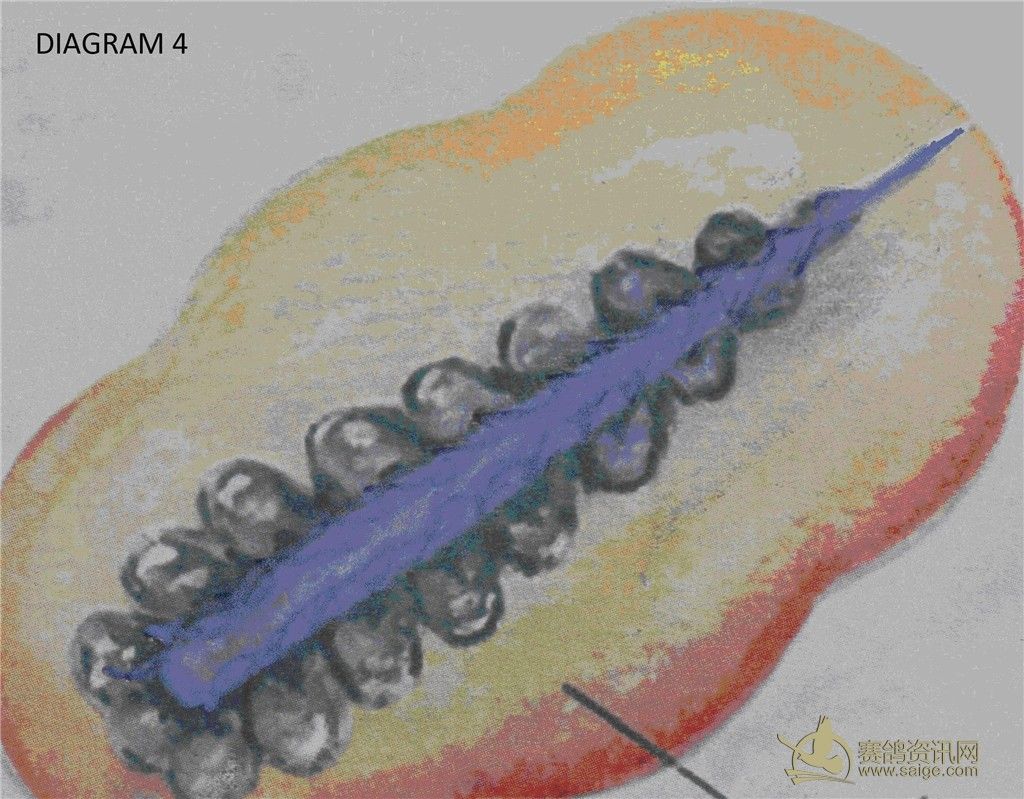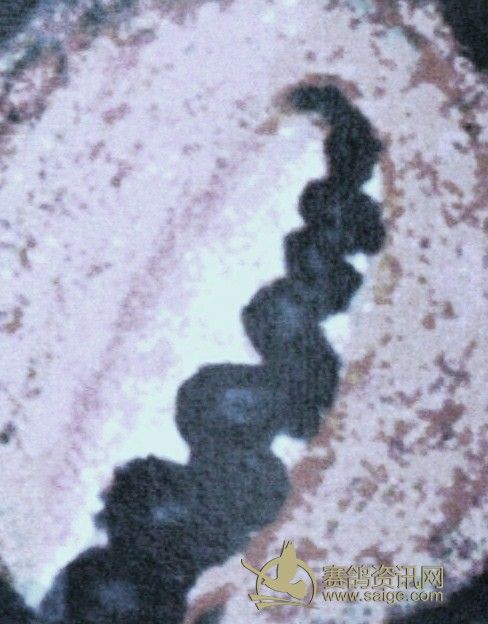”¢Œƒ∞Ê°™Éû(y®≠u)–„Ÿê¯ù—€ô±ƒ§—–æø ◊˜’þ:ÒT¿ÔöW
THE RESEARCH ON
PECTEN OCULI OF ACE PIGEONS
(Author: Leo Feng)
°°°°Any sort of theory begins with an assumption. It is only through numerous repeated verifications could a correct conclusion be reached.
°°°°Through the apprenticeship with Mr. Hongquan Sun, a master of pigeon eye certification in China, and my over five years of research during which I have visited nearly 100 breeding lofts in Belgium and the Netherlands, and observed 2,307 racing pigeons, I believe that all ace breeders and racing pigeons exhibit unique characteristics in their pecten oculi (retina). As such, I have written this thesis to provide some factual information. The purpose of its conclusions is to draw from others more valuable ideas. Racing pigeon breeding and certification will invariably involve the understanding of the families and characteristics of these pigeons i.e. their homing ability, speed, distance and agility. Adhering strictly to a single breeding and certification method may induce errors.
°°°°Method:Adjust the refraction wheel on the ophthalmoscope to the 20 mark. Use one hand to hold the pigeon tight while keeping it still as much as possible, with its tail up and head down at a 45°„ angle. Use the other hand to keep the pigeon head stable so that the distance between the pigeon eye and the ophthalmoscope is about 3 to 4 cm. Then use the hand holding the pigeon head to adjust the angle and the distance from the head to ensure the light from the ophthalmoscope can reach inside the eye through the pupil so that you can see the retina and the external characteristics of the pecten oculi.
°°°°A.Pecten Oculi Lamella (See Diagram 2)
°°°°1. Golden Lamella ®CThe entire body is orange yellow in colour, sometimes ochre, usually with shiny lines. This is found in crossbreds produced from high quality purebreds or inbreds, mostly potential racing pigeons and ace breeds (see Diagram 3).

°°°°Explanations:Golden Lamella is of the top class. The comb leaves and comb stems are regarded as two separate levels, with the comb ridges being the third level. The comb stem features a jagged edge, pressing onto the orderly arranged comb leaves. The orange (beige) lamella is clear and bright, mostly found in Golden Breeders. It can improve the quality of the racing pigeons, especially their flight endurance. Ochre and dark yellow ones are relatively dull in colour, and some may not be even in tone, displaying gradual changes from dark to light or dull to shiny. Irrespective of its tone, the entire lamella is of one single colour. It appears to be scattered with blurry golden dusts and spots, with comparatively more of its comb leaves scarlet in colour.
°°°°2. Silver Lamella ®CIts entire body is bluish grey in colour, with a large area of exposed optic nerves. Those with white frost on the comb leaves are named °∞Christmas Trees°±. Pigeons with such feature are all quality breeds, mostly are top class inbreds (see Diagram 4).

°°°°Explanations:In most cases, comb leaves and comb stems do not appear in the same colour. They have different colours but with frosted surface. Some look blurry with shiny lines and ridges.
°°°°3. Bronze Lamella ®CIts colour is an assortment of different shades of brown, mostly found in crossbreds from better quality performance pigeons (see Diagram 5).

°°°°Explanations:The lamella features shiny lines. Since it is not of the homozygous genotype, its DNA chain is complicated and is of less breeding value than the Golden and Silver Lamellae. Pairing requires more techniques and experiences.
°°°°4. Iron Lamella ®C The entire body is dark grey in colour with varying degrees of shades, not much variation though (see Diagram 6).

°°°°Explanations:Both inbreds and crossbreds could feature this type of colour, but mostly are of mixed lineages. They demonstrate high flight speed during sunny days and comparatively high agility, but may individually display some form. of nervousness.
°°°°Conclusions:
°°°°1. Lamella colour is a correlated indicator of the quality of the racing pigeons.
°°°°2. Lamella colour is of a single tone ®C purebreds, ace quality.
°°°°3. Lamella exhibits clarity and brightness ®C original ecology, healthy.
°°°°4. Lamella is slender in shape ®C high speed.
°°°°5. Lamella is short and broad in shape ®C stable, average speed.
°°°°6. Lamella is convex or partially convex in shape ®C heredity is comparatively more effective.
°°°°7. Frequent vibration of the entire pecten oculi ®C energetic, agile.
°°°°B.Comb Vein
°°°°Comb veins are exposed cranial nerves. Pigeons with silvery white or yellow comb veins are of excellent quality. When far away from home, their reactions towards earth magnetism, atmospheric odour, sunray, geography and landmark are more stable and therefore more accurate in their orientation (see Diagrams 7 & 8).
°°°°1. Ridges can appear anywhere along the centre line of the lamella and above it, which can take the form. of spots or lines. Their length, width, thickness and colours are different, some extend the entire length, others may just be fragments in the head, the middle or the tail section. There is also one type of ridges that are raised much higher above the surface.
°°°°2. Lines can appear anywhere on the lamella, either white, greyish white or light yellow in colour.
°°°°3. Dusts, like starlets, can appear anywhere on the comb leaves; quantity varies and mostly found in comb leaves.
°°°°4. Spots are like shiny fragments sprinkled on the lamella; quantity varies and colour is mainly golden yellow or white.
°°°°5. Frosting is the exposure of optic nerves, resembling a layer of frost on the lamella and comb leaves; quantity varies without clear boundaries, most of them look like fog.
°°°°Conclusions:
°°°°1. The presence of ridges, lines, dusts, spots and frost indicates the quality of the racing pigeons; presence is better than absence, clarity is better than blurriness, and more is better than less.
°°°°2. Frost or fog appearing in the lamella head is good for breeding; and in the tail, excellent for racing.
°°°°3. Ideally, these should appear in the tail because this is the secret to winning races.
°°°°4. Dusts and spots are a (diminutive) form. of frost, yet their value and quality are not as good.
°°°°C.Comb Leaf
°°°°1. A high quality comb leaf is like a flower, pink and scattered with shiny spots. The leaf is thick and where it joins the lamella is strong and tight.
°°°°2. The comb leaf is pointed (jagged) in shape with a tapering end which is the feature of fast potential racing pigeons; high density mostly indicates good mid-range racing pigeons.
°°°°3. Pigeons with comb leaves that are round in shape are of the long range category.
°°°°4. Long and round comb leaves demonstrate great endurance in potential racing pigeons.
°°°°Conclusions, attributes for excellence and speediness:
°°°°1. Slender, basically of the same width from top to bottom.
°°°°2. The pecten oculi lamella facing the comb leaf transitional area is in a jagged shape like a ladder.
°°°°3. When the comb vein extends on the lamella, its length, width, thickness, brightness or intensity appears bluish grey.
°°°°4. Comb leaves that are thick with shiny pastel spots like flowers are the best.
°°°°5. The quantity of comb leaves can roughly determine the suitable range of a racing pigeon; the higher the quantity of comb leaves, the longer the range.
°°°°D.Comb Head
°°°°Located at the lower part of the pecten oculi (at the corner), this part of the lamella is usually flat and wide. The comb leaves are relatively thick and well developed. If positive attributes such as frost, lines or dusts are present in the lamella or on the comb leaves, the breeding ability will be strong. This is called the breeding area.
°°°°E.Comb Tail
°°°°Discrepancies exist between excellence and mediocrity. Its detailed and overall shape reflects the quality of the racing pigeons i.e. their inherited homing ability, speed, distance and agility. Adjust the refraction wheel on the ophthalmoscope to the black mark of 5 or 6 for observation.
°°°°1. The tail is located at the upper part of the pecten oculi (posterior cerebral area), occupying approximately one-sixth of the entire pecten oculi. °°°°This part of the lamella is usually narrower, some shrunken to tiny pointed shape with comb leaves retracted accordingly. There are great variations in its appearance, but it provides primarily the information on the quality of the racing pigeons.
°°°°2. If the comb leaves in the comb tail exhibit frosting, this pigeon is of excellent breed.
°°°°3. At the tapering end of the comb tail, the densely populated little black dots and minuscule silky hair appearing on the tiny dark grey stems are the optic nerves. As for optic nerves (those densely populated little black dots and minuscule silky hair), dense is better than scarce, and bright peripheral colour is better than dull. If the joints between comb leaves are also dense with dots, the quality is even higher.
°°°°4. At the tapering end of the comb tail, the stem cannot be askew and irregular or curved at the top, otherwise this indicates inferiority in the quality and needs to be eliminated. See the diagram below.

°°°°5. Shaped like the head of a matchstick, this is of the top class breeder and racing pigeons. See the diagram below.
°°°°6. Shaped like a metal brush, this is more outstanding in mid-range breeding than taking part in races. See the diagram below.
°°°°7. Shaped like branches, this indicates inconsistencies in racing results; more suitable for breeding if it features golden / silver lines. See the diagram below.
°°°°8. Shaped like a tower, this indicates consistency in mid-range racing, characteristic of good racing pigeons and breeders. See the diagram below.
°°°°9. Shaped like a tapered rope, this is the characteristic of long range racing pigeons. See the diagram below.
°°°°F.Notes for Pairing
°°°°1. To reproduce offsprings of the same quality, try to pair as far as possible pigeons with similar pecten oculi, close lamella shape and symmetrical eyes.
°°°°2. One of the pair is an all-round ace while the other is a partly top class ace. The purpose is to reproduce offsprings with certain aspect strengthened or even exceeding the parents e.g. to possess the ability of withstanding adverse weather. Try to pair a brown lamella with a yellowish one, or crossbreed reddish ones.
°°°°3. To boost the flight speed, pair one with shiny lines with another one with long shiny lines.
°°°°4. Pair one with jagged comb leaves with ladder comb leaves; make sure to find ones with orderly arrangements for pairing.
°°°°5. Heredity is the most effective for those with white frost and long shiny lines which can be paired with any types. Offsprings whose pecten oculi are not achieving the standard of 80% or are too far from expectations should be broken up as early as possible and re-paired.
√‚ÿü¬ï√˜£∫±ææW(w®£ng)∑≤ «”…”√ëÙ∞l(f®°)≤ºµƒŒƒ◊÷°¢àD∆¨��°¢“Ù“ïÓlµ»ŸY¡œ£¨∆‰’Êåç–‘����°¢ú ¥_–‘∫Õ∫œ∑®–‘”…–≈œ¢∞l(f®°)≤º»À◊‘––≥–ì˙��£¨≤¢ÿì∑®¬…ÿü»Œ���°£Ÿê¯ùŸY”çæW(w®£ng)≤ªÃ·π©»Œ∫Œ±£◊C��£¨≤¢≤ª≥–ì˙»Œ∫Œ∑®¬…ÿü»Œ��°£
















